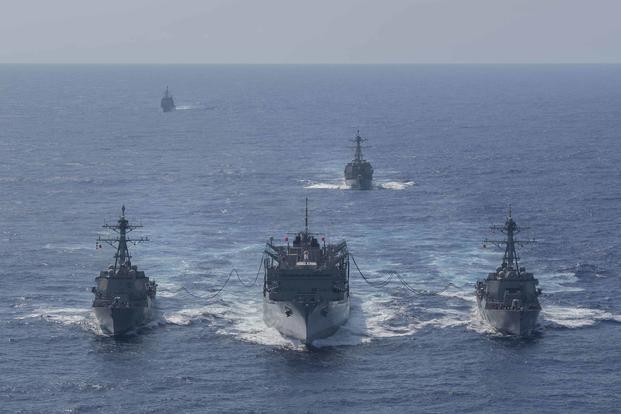The Navy is moving to expand its presence in the Arctic.
The service’s newly reestablished 2nd Fleet has stood up a temporary expeditionary maritime operations center out of Keflavik, Iceland in recent weeks to give U.S. naval vessels a more competitive edge in a region where international interest is growing, according top service officials.
The guided-missile cruiser Normandy and destroyer Farragut have begun working in the harsh waters of the High North as they practice navigating in a region that Russia calls its backyard.
"The North Atlantic is becoming more of a competitive space than it has been for the last number of years," Second Fleet commander Vice Adm. Andrew "Woody" Lewis said in a phone call with reporters Wednesday. "[It's] an imperative that we get up there and operate regularly."
Related: Norway Worries Melting Arctic Ice Will Incite Drone Ops and Conflict
"If you look at a map of the Arctic, and you look at the distances, and then you look at what we have for supportability ... it's not much," Lewis said. "Everything is an expeditionary capability -- expeditionary refueling, expeditionary loading of supplies and ... we have to ... equip the ship differently and have to go out with a different mindset."
The most ordinary tasks will become a struggle, he said. As an example, sailors will have to consistently evaluate "things as simple as, 'What kind of clothing that a sailor is wearing on exposed weather decks?'" he added.
The operations center in Keflavik has roughly 30 personnel to act as liaisons between the ships, 2nd Fleet headquarters in Norfolk, Virginia, and Naval Forces Europe.
Last year's Trident Juncture exercise took place near the Arctic Circle with the Harry S. Truman Carrier Strike Group participating. That gave the Navy a taste of the region's bleak conditions, but the service needs to make training in a cold-weather environment the norm, said Capt. Chris Slattery, expeditionary Maritime Operations Center director.
"Conditions here require additional considerations for all aspects of naval operations, from navigation, to logistics and medical support, to communications," he said.
The guided-missile destroyers Lassen and Forrest Sherman are also in the Atlantic, but will not join the Normandy and Farrugut in the Arctic Circle, officials said. For now, the four ships of the Truman Carrier Strike Group are making up a surface action group (SAG); the Truman was unable to deploy due to an electrical malfunction.
Lewis said the Truman should be able to rejoin the group, but could not provide a timeframe for its arrival.
The SAG, expeditionary by design, is a "deliberate effort to provide more decision space at sea," he said.
In 2018, then-Chief of Naval Operations Adm. John Richardson re-established 2nd Fleet, which had deactivated in 2011, to increase the service's ability to operate from the Eastern seaboard to the Barents Sea, where Russia operates its nuclear-powered and conventional submarines.
While last year's Trident Juncture -- which brought nearly 50,000 U.S. and NATO forces together for the largest iteration of the drill since 1991 -- was a clear deterrence message to Russian forces, Lewis said the latest operations aren't meant to poke the bear.
"The key to this is being strategically predictable to our allies and partners and operationally unpredictable to our competitors," he said, adding the Navy will maintain a "professional posture."
Lewis and Slattery said there haven't been any hostilities or increased malign activity from the Russian side. But "our intention was to get up into the Arctic and be able to prove to ourselves that we can get there without being noticed on the way," Lewis said.
"There's no real Russian assets, whether air surface or subsurface, within the proximity of the Northern [surface action group]," added Slattery. "There's hasn't really been an opportunity for any of that interaction."
But "I'm sure the longer we stay up here, that opportunity would increase," he said.
-- Oriana Pawlyk can be reached at oriana.pawlyk@military.com. Follow her on Twitter at @Oriana0214.
Read more: More US Military Power Needed in Antarctic to Deter Malign Activity, General Says












